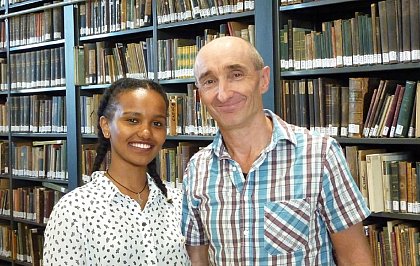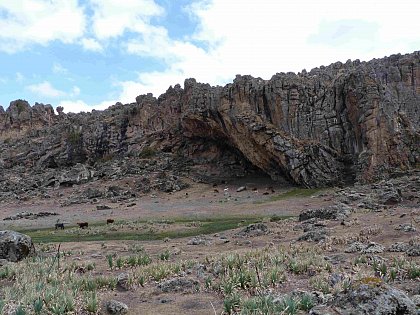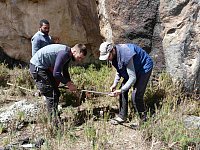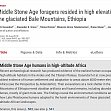FOR 2358: Anthrosole of the Bale Mountains
Mountain Exile Hypothesis: How humans benefited from and re-shaped African high altitude ecosystems during Quarternary climatic changes

Betelhem Mekonnen and Prof. Bruno Glaser
From 2016
- Project sponsor: DFG – German Research Foundation
- Project leaders: Prof. Dr. Bruno Glaser, Prof. Dr. Wolfgang Zech
- Staff: Tobias Bromm, Betelhem Mekonnen
Subproject: Anthrosoils of the Bale Mountains: Archives for the reconstruction of settlement chronology and intensity, as well as interactions with fire and the destruction of Erica vegetation on the Sanetti

Rock ledge used by humans (photo: Marianne Benesch)
This project will investigate the chronology and intensity of human settlement in the Bale Mountains and its impact on the deforestation of the Sanetti Plateau through fire. To investigate these relationships, we will focus on the following points: 1. In collaboration with Project P1 (Archaeology), we will investigate the chronology (using radiocarbon and optically stimulated luminescence dating) and the type and intensity of human settlement. For this purpose, anthrosols under rock ledges and caves serve as archives and molecular markers as land use indicators, such as phosphorus mapping (Birk et al. 2007), benzene polycarboxylic acids (Glaser et al. 1998) and sterols and bile acids as faecal biomarkers (Birk et al. 2012).

Soil sampling (photo: Marianne Benesch)
2. In collaboration with projects P3 (basic environmental data collection) and P7 (ground beetles), we will collect data on typical site characteristics (soils and topography). These data will enable us to reconstruct the former distribution of Erica as well as current actual and potential Erica sites. 3. With the same intention, we will investigate potential molecular Erica markers such as cutin and suberin (Spielvogel et al. 2014), CuO lignin and monosaccharides (Spielvogel et al. 2007; Eder et al. 2010), phytoliths (Iriarte et al. 2010), n-alkanes, stable isotope signatures (Glaser and Zech 2005). If no Erica-specific biomarkers are found, we will use metabolomics techniques to distinguish between Erica and grass vegetation in the soil. 4. To identify possible interactions between human settlement and the temporal and spatial dynamics of Erica vegetation, sediments from concave glacial deposits on the Sanetti Plateau will be examined using the molecular markers described above. We assume that the chronology and intensity of fire determine the dynamics of Erica vegetation. In collaboration with P4 (palaeoecology, pollen) and P5 (palaeoclimatology, 18O sugar), we will identify whether the burning of Erica sites is determined more by human settlement or by palaeoclimatic fluctuations.
Press article: www.magazin.uni-halle.de
Press article on the Science publication: www.pressemitteilungen.pr.uni-halle.de






